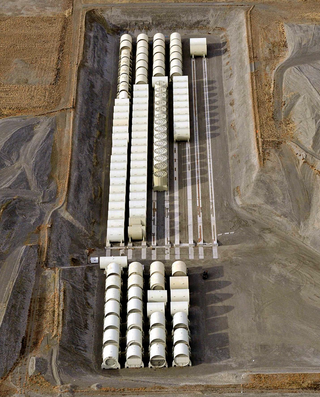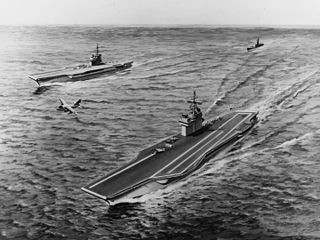
United States naval reactors are nuclear reactors used by the United States Navy aboard certain ships to generate the steam used to produce power for propulsion, electric power, catapulting airplanes in aircraft carriers, and a few more minor uses. Such naval nuclear reactors have a complete power plant associated with them. All commissioned U.S. Navy submarines and supercarriers built since 1975 are nuclear powered, with the last conventional carrier, USS Kitty Hawk, being decommissioned in May 2009. The U.S. Navy also had nine nuclear-powered cruisers with such reactors, but they have since been decommissioned as well.

The Nimitz class is a class of ten nuclear-powered aircraft carriers in service with the United States Navy. The lead ship of the class is named after World War II United States Pacific Fleet commander Fleet Admiral Chester W. Nimitz, who was the last living U.S. Navy officer to hold the rank. With an overall length of 1,092 ft (333 m) and a full-load displacement of over 100,000 long tons (100,000 t), the Nimitz-class ships were the largest warships built and in service until USS Gerald R. Ford entered the fleet in 2017.

USS Enterprise (CVN-65), formerly CVA(N)-65, is a decommissioned United States Navy aircraft carrier. In 1958, she was the first nuclear-powered aircraft carrier and the eighth United States naval vessel to bear the name. Like her predecessor of World War II fame, she is nicknamed "Big E". At 1,123 feet (342 m), she is the longest naval vessel ever built and the only ship of a class that was originally planned to have five other ships. Her 93,284-long-ton (94,781 t) displacement ranks her class as the third largest carrier class, after the Nimitz class and the Gerald R. Ford class. Enterprise had a crew of some 4,600 service members.
The A2W reactor is a naval nuclear reactor used by the United States Navy to provide electricity generation and propulsion on warships. The A2W designation stands for:
The A3W reactor was a naval reactor used by the United States Navy to provide electricity generation and propulsion on warships. Like all operational U.S. naval reactors it was a pressurized water reactor (PWR) design. The A3W designation stands for:
The A4W reactor is a naval reactor used by the United States Navy to propel warships and generate onboard electricity.

The Gerald R. Ford-class nuclear-powered aircraft carriers are currently being constructed for the United States Navy, which intends to eventually acquire ten of these ships in order to replace current carriers on a one-for-one basis, starting with the lead ship of her class, Gerald R. Ford (CVN-78), replacing Enterprise (CVN-65), and later the Nimitz-class carriers. The new vessels have a hull similar to the Nimitz class, but they carry technologies since developed with the CVN(X)/CVN-21 program, such as the Electromagnetic Aircraft Launch System (EMALS), as well as other design features intended to improve efficiency and reduce operating costs, including sailing with smaller crews. This class of aircraft carriers is named after former U.S. President Gerald R. Ford. CVN-78 was procured in 2008 and commissioned into service on 22 July 2017. The second ship of the class, John F. Kennedy (CVN-79), is scheduled to enter service in 2025.
The A1W reactor is a prototype nuclear reactor used by the United States Navy to provide electricity generation and propulsion on warships. The A1W designation stands for:

Nuclear marine propulsion is propulsion of a ship or submarine with heat provided by a nuclear reactor. The power plant heats water to produce steam for a turbine used to turn the ship's propeller through a gearbox or through an electric generator and motor. Nuclear propulsion is used primarily within naval warships such as nuclear submarines and supercarriers. A small number of experimental civil nuclear ships have been built.
A nuclear navy, or nuclear-powered navy, refers to the portion of a navy consisting of naval ships powered by nuclear marine propulsion. The concept was revolutionary for naval warfare when first proposed. Prior to nuclear power, submarines were powered by diesel engines and could only submerge through the use of batteries. In order for these submarines to run their diesel engines and charge their batteries they would have to surface or snorkel. The use of nuclear power allowed these submarines to become true submersibles and unlike their conventional counterparts, they became limited only by crew endurance and supplies.

The General Electric LM2500 is an industrial and marine gas turbine produced by GE Aviation. The LM2500 is a derivative of the General Electric CF6 aircraft engine.

The CG(X) program, also known as the Next Generation Cruiser program, was a United States Navy research program to develop a replacement vessel for its 22 Ticonderoga-class cruisers. Original plans were for 18–19 ships, based on the 14,500 ton Zumwalt-class destroyer with additional ballistic missile defense and area air defense for a carrier group. These vessels were to enter service beginning in 2017. The program was ended in 2010 with its mission to be fulfilled by the successor to the Flight III Arleigh Burke-class destroyers.

Machinist's mate is a rating in the United States Navy's engineering community.

The S6W reactor is a naval reactor used by the United States Navy to provide electricity generation and propulsion on warships. The S6W designation stands for:
In the United States Navy, Refueling and Overhaul (ROH) refers to a lengthy refitting process or procedure performed on nuclear-powered naval ships, which involves replacement of expended nuclear fuel with new fuel and a general maintenance fix-up, renovation, and often modernization of the entire ship. In theory, such process could simply involve only refueling or only an overhaul, but in practice, nuclear refueling is always combined with an overhaul. An ROH usually takes one to two years for submarines and up to almost three years for an aircraft carrier, performed at a naval shipyard. Time periods between ROHs on a ship have varied historically from about 5–20 years (for submarines) to up to 25 years (for Nimitz-class aircraft carriers). For modern submarines and aircraft carriers, ROHs are typically carried out about midway through their operating lifespan. There are also shorter maintenance fix-ups called availabilities for ships periodically at shipyards. A particularly lengthy refueling, maintenance, and modernization process for a nuclear aircraft carrier can last up to almost three years and be referred to as a Refueling and Complex Overhaul (RCOH).
The United States Navy Nuclear Propulsion community consists of Naval Officers and Enlisted members who are specially trained to run and maintain the nuclear reactors that power the submarines and aircraft carriers of the United States Navy. Operating more than 80 nuclear-powered ships, the United States Navy is currently the largest naval force in the world.

The Aircraft Carrier (Medium) (CVV) was an American design for a conventional-powered (i.e. non-nuclear-powered) aircraft carrier proposed in the 1970s. It was to be smaller and cheaper than the contemporary nuclear-powered Nimitz class. A single example was planned, but was not built, with further Nimitz-class carriers built instead.

Vice Admiral Thomas J. Moore was a senior officer in the United States Navy. He retired from active duty on June 19, 2020, after 39 years of service. He currently serves as Vice President of Nuclear Operations at Huntington Ingalls Industries.











